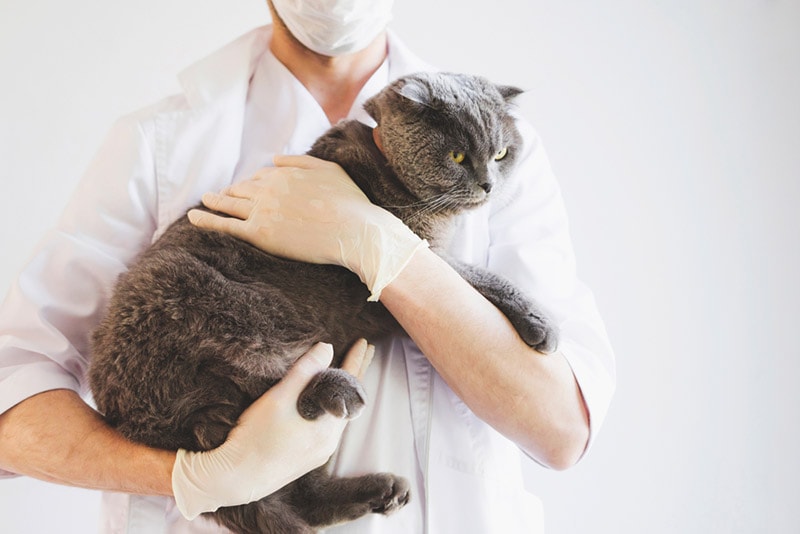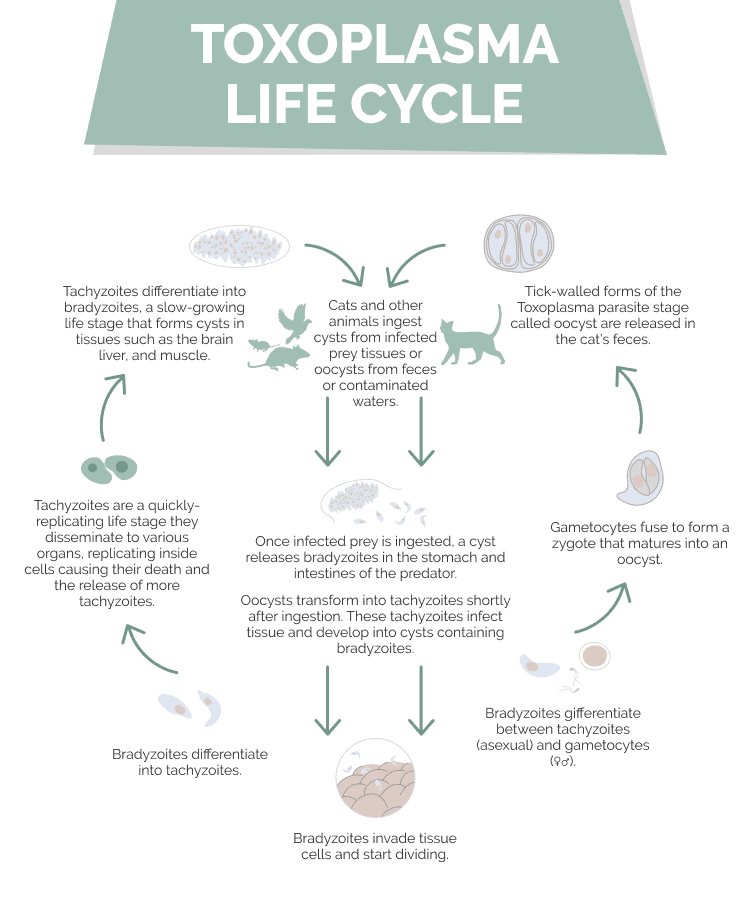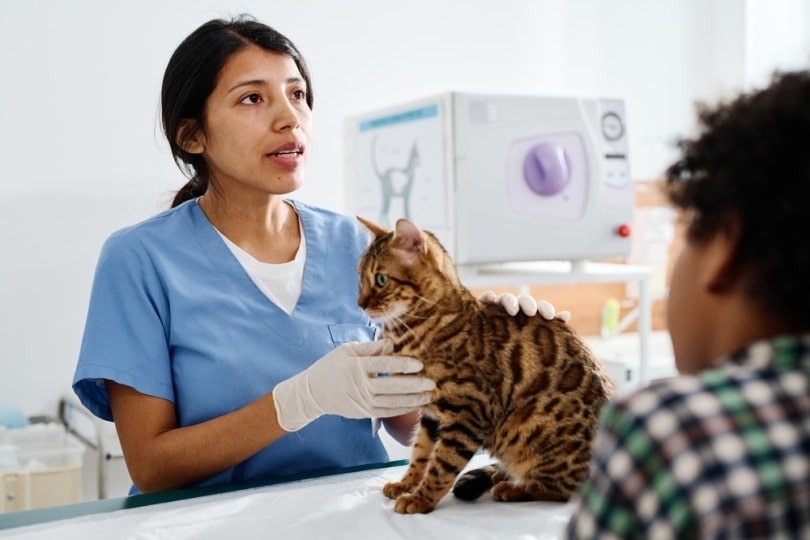Coccidia in Cats: Causes, Signs & Treatments (Vet Answer)

Updated on

Click to Skip Ahead
Coccidiosis is a parasitic disease caused by unicellular organisms (protozoa) called coccidia. This condition is often found in pets, and it can cause a series of health problems, from digestive disorders to extreme dehydration. In severe cases, it can even lead to death.
The most commonly found coccidia in cats is Isospora (Cystoisospora), so the term coccidiosis is frequently used to name the infection caused by this type of parasite. It mainly affects young animals, especially during the weaning period, typically circulating among animals raised in densely populated conditions and inadequate hygienic conditions, where it causes significant losses.
In this article, you can learn about coccidiosis, including its causes, clinical signs, and treatment, and what you can do for your cat.
What Is Coccidia?
Coccidia is part of the class Sporozoa, phylum Apicomplexa. Sporozoa are exclusively parasitic protozoa (unicellular organisms, i.e., consisting of a single cell), mostly intracellular, which in their development cycle, go through the spore stage.
- Hammondia
- Isospora
- Besnoitia
- Toxoplasma
- Sarcocystis
These unicellular organisms develop and multiply in the intestinal cells of infected cats, leading to various signs, such as inflammation and digestive disorders.
The life cycle of coccidia is short but complex and involves several stages. Infection occurs orally by ingestion, the mode of transmission being oral-fecal. Initially, cats can become infected by ingesting sporulated oocysts, which is one of the life cycle forms of coccidia (the infectious state of the parasite). Oocysts can survive in the environment or the feces of other infected animals and develop from the unsporulated form to the sporulated form. Once ingested, the sporulated oocysts reach the stomach, where they are subjected to digestive juices, which leads to the release of sporozoites.
The sporozoites enter the intestinal cells (enterocytes), where they multiply and form merozoites. The merozoites then release new oocysts, which are released into the external environment along with the infected cat’s feces. Thus, contaminated feces can infect other animals and continue the life cycle of the parasite.
In order for the sporulation process to take place (i.e., for the oocysts to become infectious), certain environmental conditions must be met, such as those relating to oxygen, humidity, and heat. If the oocysts have all these conditions, sporulation takes place in a few hours to a few days.

What Are the Signs of Coccidia?
This condition occurs most often in kittens and debilitated adult cats. Clinical signs can occur from the age of 2 weeks to 6 months. Weaning can also cause stress and leave kittens vulnerable to infection.
Although many cats infected with coccidia are asymptomatic, the manifestations of this disease can vary depending on the severity of the infection or the species of coccidia. However, the most common clinical signs of coccidiosis in cats are:
- Diarrhea (watery or mucus-like)
- Dehydration
- Abdominal pain
- Loss of appetite
- Weight loss
- Vomiting
- Uveitis (inflammation of the uvea)
- Pneumonia with breathing problems (in toxoplasmosis)
In severe cases (in kittens and debilitated adult cats), death can also occur. Some cats can be carriers of coccidia without showing any clinical signs, especially if they have a strong immune system. However, they can still spread the parasite in the environment, which can lead to the infection of other animals.
What Are the Causes of Coccidia?
The cause of infection with coccidia is represented by the ingestion of infectious oocysts. The sources of infection are other infected animals, which may or may not show clinical signs. The transport of oocysts could be provided by insects, water, food, and hair soiled with infected feces.
In the case of Isospora, rodents are a possible source of infection but other animal species could also intervene. Contamination is achieved when cats ingest the infectious oocysts along with water and contaminated food or infected intermediate hosts.
Adult cats are generally carriers and eliminators of oocysts, without presenting any clinical signs. Kittens that are in the weaning period are the most sensitive to infection. The susceptibility to infection is maintained until the age of 6–8 months, as the kitten’s immune system is not fully developed.
How Is Coccidiosis Diagnosed?
Diagnosing coccidiosis in cats is done by examining the fecal material under a microscope. This exam has the role of highlighting the presence of oocysts.
For some coccidia, though, such as Toxoplasma spp., specific antibody blood tests are needed to confirm the diagnosis.
What Is the Treatment for Coccidia in Cats?
Once the veterinarian confirms the diagnosis, they will recommend an appropriate treatment to combat the infection and improve your cat’s clinical signs.
Treatment usually includes the administration of anticoccidial drugs and supportive therapy. The anticoccidial drugs have the role of killing coccidia, stopping their development. The duration and dosage of the treatment will be determined by your vet, depending on the severity of the infection and the general health state of your cat.
The supportive treatment has the role of rehydrating your cat in case they vomit and have diarrhea. The vet can also recommend supplements and medications to control pain and inflammation and stimulate your cat’s appetite.
For cats with diarrhea, the vet can recommend supplements that will help restore the microbial flora, such as probiotics and prebiotics. They can help recover the intestine’s microbiome and reduce the side effects of the medicated treatment.
How Do I Care for a Cat With Coccidia?

Take your cat to the vet as soon as they have clinical signs to receive a correct diagnosis and appropriate treatment. Then, follow the vet’s recommendations, and closely monitor your cat’s condition during treatment to ensure a quick and complete recovery.
- Vaccinate and deworm your cat regularly.
- Clean the environment where your cat lives. Clean and disinfect the areas where your cat sleeps, eats, and plays. Remove their feces regularly to reduce the risk of oocyst contamination.
- Feed your cat a high-quality, balanced diet. It will help them have a strong immune system that will be able to fight potential infections.
- Avoid letting your cat hunt or ingest wildlife.
Frequently Asked Questions (FAQ)
What Does Coccidia Poop Look Like in Cats?
Cats infected with coccidia may have soft, watery stools or diarrhea. The diarrhea can be smelly and have mucus or blood. However, this clinical sign can also occur with other medical conditions or infections, so you’ll need to take your cat to the vet for a definitive diagnosis and appropriate treatment once you notice this sign in your pet.
Is Coccidia Contagious to Humans?
The coccidia that most commonly infect cats (Isospora) can’t be transmitted to humans, as these parasites are host specific. However, both Toxoplasma and Cryptosporidiumspecies can infect humans, especially those who are immuno-compromised.
What Happens If Coccidiosis Goes Untreated?
If coccidiosis is left untreated, it can lead to dehydration, weight loss, and even death. Clinical signs of infection include diarrhea, vomiting, anorexia, weight loss, and dehydration.
If your cat shows clinical signs, take them to the vet to establish the diagnosis. However, adult cats usually do not show any signs, as they are only carriers and eliminators of oocysts.
Conclusion
Although several species of coccidia can infarct cats, the most commonly found is Isospora (Cystoisospora). The term coccidiosis is frequently used to name the infection caused by this type of parasite. Kittens or adult cats with weak immune systems are most susceptible. Most cats are asymptomatic, as they only carry and eliminate the infectious forms of the parasite. However, other cats may experience vomiting, diarrhea, lethargy, dehydration, and lack of appetite.
In the case of toxoplasmosis, cats that develop a clinical disease can have pneumonia with breathing difficulties and septic shock. If your cat shows the clinical signs, it is recommended to go to the veterinarian because if left untreated, coccidiosis can be fatal. Fortunately, it is treatable and the prognosis is favorable.
Featured Image Credit: Alice Rodnova, Shutterstock












